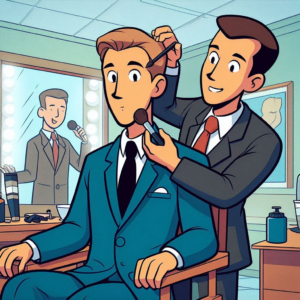Hey there, future world-changers and corner-office dreamers! Ever wondered why some leaders can rally troops with a single raised eyebrow, while others struggle to organize a tea party in a china shop? Well, buckle up, buttercup, because we’re about to embark on a wild ride through the jungle of leadership styles, where we’ll wrestle with our strengths, tame our weaknesses, and maybe learn a thing or two about ourselves in the process.
The Leadership Tango: It Takes Two (Skills) to Groove

Leadership isn’t just about barking orders from a mahogany desk (although that does sound pretty fun). It’s a delicate dance of skills, personality traits, and the occasional coffee-fueled brainstorming session. But before you can lead the conga line of success, you need to know your moves – and more importantly, where you might trip over your own feet.
So, let’s cut to the chase: What makes a good leader? Is it the ability to recite Sun Tzu’s “The Art of War” backwards while juggling flaming swords? Not quite (though that would make for an epic team-building exercise). The secret sauce of leadership is a blend of self-awareness, adaptability, and a dash of humility. Oh, and don’t forget the sprinkle of charisma on top – it’s like the cherry on your leadership sundae.
Strengths: Your Leadership Superpowers
Every leader has their own set of superpowers. Maybe you’re the Empress of Empathy, capable of understanding your team’s needs before they even voice them. Or perhaps you’re Captain Communication, able to explain complex ideas with the clarity of a thousand PowerPoint presentations.
Here are some common leadership strengths that might be hiding in your cape closet:
- Visionary Thinking: You can see the big picture clearer than a 4K ultra-HD TV.
- Decision-Making: You slice through tough choices like a hot knife through butter.
- Emotional Intelligence: You’re fluent in the language of feelings (no Google Translate needed).
- Integrity: Your moral compass is so strong, it could guide ships through a storm.
- Adaptability: You’re more flexible than a yoga instructor on a rubber mat.
But how do you identify these strengths? Well, you could wait for a radioactive spider bite, or you could try these more practical methods:
- Self-reflection: Take a good, hard look in the mirror (metaphorically, please – we don’t want any broken glass incidents).
- Feedback: Ask your team what they think. Just be prepared for brutally honest answers like, “You make great coffee, boss!”
- Personality assessments: Take a test like the HIGH5 or Myers-Briggs. It’s like astrology, but for professionals!
Remember, knowing your strengths is only half the battle. The real magic happens when you leverage them to inspire your team, tackle challenges, and occasionally impress your cat with your leadership prowess.
Weaknesses: The Kryptonite in Your Corner Office

Now, let’s address the elephant in the room (no, not Bob from accounting – we told him the “elephant costume Fridays” idea wouldn’t catch on). We’re talking about weaknesses. Those pesky little quirks that make us human and occasionally make us want to hide under our desks.
Here are some common leadership weaknesses that might be lurking in your professional closet:
- Micromanagement: You’re so hands-on, your team thinks you’re part octopus.
- Lack of Delegation: You believe in the “if you want something done right, do it yourself” mantra… for everything.
- Poor Listening Skills: You hear your team, but are you really listening? (Hint: nodding while scrolling through cat memes doesn’t count).
- Avoiding Conflict: You’d rather eat a cactus than have a difficult conversation.
- Inability to Adapt: Change scares you more than a clown at midnight.
Identifying these weaknesses isn’t about beating yourself up. It’s about growth, baby! Here’s how to spot them:
- Self-awareness: Pay attention to situations that make you uncomfortable or where you consistently struggle.
- 360-degree feedback: Get input from your superiors, peers, and subordinates. It’s like a roast, but for your career!
- Performance reviews: Look for patterns in your evaluations. If “needs improvement in interpretive dance skills” keeps coming up, you might want to address that.
Remember, everyone has weaknesses. The key is acknowledging them, working on them, and maybe turning them into endearing quirks that your team will fondly remember in their memoirs.
The Leadership Style Buffet: Pick Your Flavor
Now that we’ve taken stock of our strengths and weaknesses, it’s time to define our leadership style. Think of it as choosing your character in a video game, but instead of fighting dragons, you’re battling budget constraints and motivating millennials.
Here are some popular leadership styles to consider:
- Transformational Leadership: You’re the Steve Jobs of your office, inspiring innovation and change. Just don’t make anyone work on Christmas.
- Democratic Leadership: You believe in the power of the people. Your motto: “Vote early, vote often, but please no ballot-stuffing in the break room.”
- Autocratic Leadership: You make decisions faster than a caffeinated cheetah. Just remember, with great power comes great responsibility (and possibly some eye-rolling from your team).
- Servant Leadership: You put your team’s needs first. It’s like being a waiter, but instead of serving food, you’re dishing out empowerment and support.
- Laissez-Faire Leadership: You give your team the freedom to do their thing. It’s French for “let them do,” not “let them eat cake” – an important distinction in office politics.
Choosing your leadership style isn’t about picking the one that sounds coolest (though “Autocratic Leader” does have a nice ring to it). It’s about finding the approach that aligns with your strengths, mitigates your weaknesses, and fits your team’s needs.
The Great Leadership Makeover: From Meh to Marvelous

So, you’ve identified your strengths, acknowledged your weaknesses, and picked a leadership style that suits you better than your favorite pair of sweatpants. Now what? It’s time for the leadership equivalent of a Rocky training montage!
Here’s how to level up your leadership game:
- Embrace continuous learning: Read books, attend workshops, or enroll in online courses. Knowledge is power, and in this case, it’s also the key to not looking like a deer in headlights during your next team meeting.
- Find a mentor: Look for someone who’s been there, done that, and got the “World’s Best Leader” mug to prove it. Their wisdom can be invaluable, even if half their stories start with “Back in my day…”
- Practice self-reflection: Set aside time to think about your actions and decisions. It’s like meditation, but instead of achieving inner peace, you’re achieving better quarterly results.
- Seek feedback regularly: Create an environment where your team feels comfortable giving you honest feedback. Just be prepared for comments like, “Your jokes are almost funny, boss!”
- Step out of your comfort zone: Take on new challenges that push your boundaries. It’s scary, but so is the thought of spending another decade in middle management.
Remember, becoming a great leader is a journey, not a destination. It’s like trying to reach the end of the internet – there’s always more to explore and learn.
The Leadership Toolbox: Essential Skills for Success
As you continue to refine your leadership style, there are some universal skills that every leader should have in their toolbox. Think of these as your Swiss Army knife of leadership – versatile, reliable, and impressively shiny.
- Communication: The ability to express ideas clearly and listen actively. It’s not just about talking; it’s about ensuring your message doesn’t get lost in translation like a game of corporate telephone.
- Emotional Intelligence: Understanding and managing your own emotions, as well as those of others. It’s like being a feelings whisperer, but with less horse-riding and more spreadsheets.
- Decision-Making: The capacity to make timely and effective choices. It’s not about always being right; it’s about being decisive enough that your team doesn’t think you’re playing eeny, meeny, miny, moe behind closed doors.
- Adaptability: The flexibility to adjust your approach based on changing circumstances. It’s like being a chameleon, but instead of changing colors, you’re changing strategies (and occasionally, the office coffee brand).
- Integrity: The commitment to ethical behavior and honesty. It’s about walking the talk, even when the talk involves admitting you binge-watched an entire season of “The Office” instead of finishing that report.
These skills form the foundation of effective leadership, regardless of your specific style or industry. They’re like the basic moves in a dance routine – master these, and you can freestyle your way through any leadership challenge with grace (or at least without stepping on too many toes).
The Leadership Balancing Act: Strengths, Weaknesses, and Everything in Between

Here’s the thing about leadership: it’s not about being perfect. It’s about finding the right balance between your strengths and weaknesses, your chosen style and your team’s needs, your visionary ideas and the harsh realities of budget constraints.
It’s like being a circus performer, juggling flaming torches while walking a tightrope… in a suit. Sounds impossible? Well, that’s the beauty of leadership – it’s challenging, exciting, and occasionally terrifying, but ultimately incredibly rewarding.
So, how do you maintain this precarious balance?
- Play to your strengths: Use your superpowers to drive your team forward. If you’re great at big-picture thinking, focus on strategy. If you’re a people person, build strong relationships.
- Manage your weaknesses: Be aware of your limitations and find ways to mitigate them. Delegate tasks that fall into your weakness zones, or partner with team members who complement your skills.
- Adapt your style: Be flexible in your approach. Sometimes you need to be the visionary leader, other times the supportive coach. Learn to read the room and adjust accordingly.
- Keep learning and growing: Never stop working on yourself. The moment you think you’ve got it all figured out is the moment you start falling behind.
- Stay humble: Remember, even Superman had kryptonite. Acknowledge your mistakes, learn from them, and move forward.
The Final Countdown: Your Leadership Action Plan
Alright, future leader extraordinaire, it’s time to put all this wisdom into action. Here’s your step-by-step guide to leadership greatness (or at least to avoiding major leadership faux pas):
- Assess your current leadership style and skills. Be honest – this isn’t the time for your Oscar-worthy performance of “I’m totally fine and know exactly what I’m doing.”
- Identify your top strengths and most challenging weaknesses. Write them down, make a vision board, tattoo them on your arm – whatever helps you remember.
- Choose a leadership style that aligns with your strengths and compensates for your weaknesses. It’s like picking an outfit – it should fit well and make you feel confident.
- Develop a plan to leverage your strengths and improve your weaknesses. Set specific, measurable goals. “Become a better leader” is too vague; “Improve active listening skills by practicing three times a week” is more like it.
- Seek feedback regularly and adjust your approach as needed. Your leadership journey is more of a winding road than a straight highway.
- Celebrate your successes, learn from your failures, and keep moving forward. Leadership is a marathon, not a sprint (though sometimes it feels like a three-legged race uphill).
Remember, becoming a great leader isn’t about transforming into someone else. It’s about becoming the best version of yourself – quirks, flaws, and all. Your unique combination of strengths and weaknesses is what makes you… well, you. And that’s exactly what your team needs.
So go forth, embrace your leadership style, work on your skills, and lead with confidence. Who knows? Maybe one day, they’ll be writing leadership books about you. Just make sure they spell your name right on the cover.
Now, if you’ll excuse me, I have a
